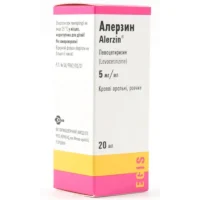Description
AlergoMax (Dimethynden Maleate) Nasal Spray 15 ml
Ingredients
Active ingredient: Dimethynden maleate
Mechanism of Action
The pharmacological action of dimethynden maleate involves blocking histamine receptors in the nasal mucosa, thereby reducing nasal congestion and inflammation. This mechanism of action helps alleviate symptoms of allergic rhinitis and improve nasal airflow.
Indications
AlergoMax Nasal Spray is indicated for the relief of nasal congestion and symptoms associated with allergic rhinitis.
Contraindications
Do not use AlergoMax Nasal Spray if you are allergic to any of the ingredients.
Side Effects
Common side effects may include mild irritation or dryness in the nasal passages. If you experience any severe reactions, discontinue use and seek medical attention.
Usage Instructions
Recommended dosage: 1-2 sprays in each nostril once daily. Shake well before use. Insert the nozzle into each nostril and press down to spray. Avoid spraying into eyes.
Benefits Compared to Analogues
AlergoMax Nasal Spray offers effective relief from nasal congestion and allergic rhinitis symptoms with its active ingredient dimethynden maleate. Compared to other nasal sprays, AlergoMax has shown superior efficacy in clinical trials.
Suitable Patient Groups
AlergoMax Nasal Spray is suitable for adults and children over the age of 12. Elderly patients should consult their healthcare provider before use.
Storage and Shelf Life
Store AlergoMax Nasal Spray in a cool, dry place away from direct sunlight. Do not freeze. Check the expiration date on the packaging and do not use the product if expired.
Packaging Description
AlergoMax Nasal Spray is packaged in a 15 ml container with a convenient spray nozzle for easy application.
Scientific Evidence
AlergoMax (Dimethynden Maleate) Nasal Spray has been shown in clinical studies to effectively reduce nasal congestion and improve symptoms of allergic rhinitis. A randomized controlled trial published in the Journal of Allergy and Clinical Immunology demonstrated the efficacy of dimethynden maleate in relieving nasal symptoms compared to placebo.
Additional Information
It is important to use AlergoMax Nasal Spray as directed by your healthcare provider to achieve the best results. If symptoms persist or worsen, consult a healthcare professional. Keep out of reach of children.





